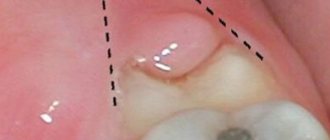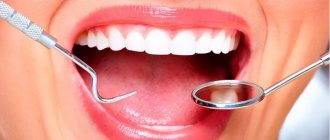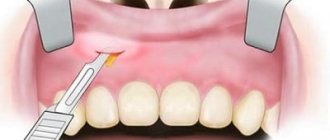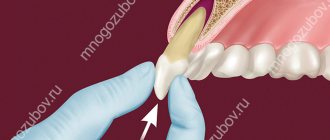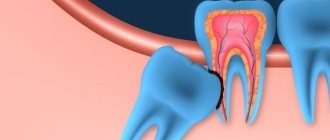Wisdom teeth or, as they are also called, eights are third molars, which, as a rule, erupt in adulthood. Since eights appear after all other dental units, there is often simply no room left for them. Therefore, their eruption is often accompanied by discomfort and pain. In some cases, pericoronitis may even develop.
In order to facilitate the process of cutting through the eighth unit, the procedure of cutting the hood is carried out.
Simple extraction
During this procedure, the gum is not cut or the bone is drilled. In this case, it is unlikely that at least part of the root will remain inside the hole. Before removing a wisdom tooth, an anamnesis of the pathological processes that are present is analyzed, and it is also determined whether there is an allergy to medications. Is it painful to remove a lower wisdom tooth? It all depends on the complexity of the process.
Here the whole process is divided into several stages:
- anesthesia;
- removal of a tooth;
- suturing the wound and its edges.
Scheme of the operation
The technique for removing a third molar directly depends on the size of the crown, the location of the tooth, the degree of its destruction, the number and shape of the roots, as well as many other factors. In particular, the extraction process can be simple or complex.
Simple removal of the "eight"
Standard surgery to remove a third molar includes the following steps:
- taking an anamnesis (identifying concomitant pathologies and allergic reactions that can jeopardize the patient’s health and life during pain relief and surgery);
- obtaining an x-ray;
- local anesthesia (Ultracaine or Lidocaine is most often used for pain relief);
- its extraction using elevators and (or) special forceps (most often, simple removal does not involve making an incision on the gum and drilling a figure eight from the jawbone);
- suturing a postoperative wound;
- prescribing antiseptics and antibiotics (if indicated);
- consultation on hygiene care issues.
Complex surgery to remove a third molar
The reasons for carrying out a complex surgical intervention to remove the “eight” may be:
- tooth retention;
- the presence of numerous, curved roots;
- too much damage to the crown and other factors.
Complex extraction differs from simple surgery in that it may require incision of the gum, drilling a “window” in the bone tissue using surgical burs and other manipulations that allow it to be removed without risk to the patient’s health. The duration of the operation increases from 10 minutes to half an hour, and in some cases up to several hours. If there are appropriate indications, complex removal is performed under general anesthesia.
Complex extraction
The preparation stage here follows the same principle. A specialist is recommended to take an x-ray to determine root growth.
Is it painful to remove an upper wisdom tooth? After the anesthesia takes effect, the pain goes away and doctors begin surgery. It is carried out according to this scheme:
- the gum tissue is cut, after which it is peeled off from the bone;
- an area that is open (part or all of it) is cut out;
- The molar is removed, using an elevator or forceps;
- the hole is inspected to see if parts of the root remain;
- the wound is washed with antiseptic, anti-inflammatory solutions;
- the hole is stitched along the edges.
They will work with you
Balinda Vadim Stepanovich Specialist in the field of orthopedic dentistry. Proficient in all methods of removable and fixed prosthetics, including metal-ceramic structures and the use of supports on dental implants; aesthetic restoration of teeth using metal-free structures.
Shakun Anton Yurievich Specialist in the field of orthopedic and surgical dentistry. Proficient in all modern types of dental prosthetics and surgical treatment, including: • aesthetic restoration of teeth with metal-free structures; • prosthetics with metal-ceramic structures; • prosthetics on dental implants; • dental implantation.
Chelnokov Sergey Fedorovich Implantologist, work experience in private practice for more than 26 years. Able to successfully perform implantation regardless of the amount of bone tissue available to the patient and the condition of the bone. Participant of many congresses and seminars on implantation in Belarus and abroad. He is a lecturer at the Intrnatinal Implant Foundation (International Implant Society).
Extraction on the lower jaw
Many people have a question: is it painful to remove a wisdom tooth from below? Surgery on the lower jaw is quite difficult, since the bone is more dense. This causes more pressure to be applied to the molar and the roots begin to grow incorrectly. This does not allow the patient to open his mouth normally, because this becomes very painful. Due to the fact that the doctor cannot clearly examine the oral cavity, the process becomes difficult. But, in order to get to the gum, you need to cut it.
Postoperative care
Increased attention should be paid to caring for the wound formed after wisdom tooth extraction. In order to prevent the development of undesirable consequences of the operation, in the postoperative and recovery period it is necessary:
- refrain from eating for 3 hours;
- exclude overly spicy, hot and hard foods from the diet;
- avoid hot baths (you can take a warm or cool shower);
- provide complete rest to the wound (it is forbidden to touch the formed hole with the tongue, toothpicks and other foreign objects, brush your teeth for two days after surgery, rinse your mouth too intensively, chew food on the side of the removed “eight”);
- avoid excessive physical activity;
- watch your facial expressions (do not make too intense facial movements);
- give up alcohol and cigarettes;
- promptly take antibacterial, anti-inflammatory, antipyretic drugs and anesthetics prescribed by the dentist;
- attend all preventive examinations prescribed by your doctor.
If any deviations from the norm are detected (bleeding from the wound lasting more than 24 hours, suppuration of the socket, too intense pain, etc.), you must consult a doctor.
Extraction on the upper jaw
Is it painful to remove a wisdom tooth from above? There is less pain here, so the procedure is faster. This point can be explained by the fact that the upper jaw has its own structural characteristics. Bone density is less, it is characterized by plasticity. There is no curvature of the root; its growth is in the right direction. Nothing interferes with surgical intervention.
To extract a wisdom tooth, forceps or an elevator are used. However, there is a risk that the root will break. To avoid such a development of events, it is better to take an x-ray.
Wisdom tooth: inflammation of the hood and its symptoms
Patients who have inflamed gums near a wisdom tooth usually complain to the doctor that their wisdom tooth is growing, their gums are swollen, and there is also an odor from the wisdom tooth. The formation of an unpleasant odor is caused by the formation of pus, which is gradually released from under the hood. Patients also complain of pain in the area of the wisdom tooth. Such symptoms correspond to only a mild form of pericoronitis.
What do the symptoms of pericoronitis look like in the video? Please note that in the video below you can see the following symptoms: redness and swelling of the hood above the upper wisdom tooth, a small amount of purulent discharge (white) from under the hood. Such symptoms correspond to a mild form of inflammation.
If pericoronitis occurs, treatment is only possible with a dental surgeon. But at the initial stage, patients try to relieve the symptoms on their own using available means: antiseptic rinses, dental drops, painkillers. In most cases, this is ineffective and the inflammation only increases. The following symptoms increase (in various combinations):
increasing pain- severe swelling and redness of the gums,
- swelling of the cheek (Fig. 4),
- purulent discharge from under the hood,
- painful swallowing
- difficulty opening the mouth,
- increase in body temperature,
- weakness,
- swelling and tenderness of the submandibular lymph nodes.
Important: if at this stage the wisdom tooth hood has not yet been removed (see below), then you should be prepared for the next development of events. Firstly, because inflammation occurs in the area of the masticatory muscles - their spasm can lead to almost complete closure of the mouth. If at this moment you decide to go to the dentist, then he will not be able to do anything for you if your mouth is not opening enough, except to refer you to the hospital.
Secondly, pus may begin to spread not into the oral cavity, but rather deep into the bone and soft tissues, which will cause the formation of an abscess or phlegmon (peripharyngeal or submandibular). The latter complications will also mean inevitable treatment in a hospital, and therefore it is better not to bring the inflammation of the wisdom tooth to a critical level.
Types of anesthesia
When a molar needs to be removed, anesthesia should be performed. There are three anesthesia options for this:
- local. Is it painful to have a wisdom tooth removed with this type of anesthesia? It is used most often. It acts in a specific area and relieves nerve endings of sensitivity;
- general anesthesia. Sometimes the patient does not have enough local anesthesia. Then anesthesia is used if the patient suffers from mental disorders, is terrified of surgery, and has a gag reflex. With such anesthesia, a person simply falls asleep;
- combined. Here, medications that promote relaxation and local anesthesia are simultaneously used. The patient remains conscious, but his emotional and physical levels decrease.
Is it painful to have a wisdom tooth removed? With high-quality anesthesia, you will not feel anything.
Question answer
- Is it really necessary to quit smoking before implantation surgery and then not smoke for another six months? Smoking is a relative contraindication. Smoking is very harmful. If initially there are many risk factors, then we warn about this and the patient himself weighs the risk of smoking.
- Will implants interfere with general X-ray diagnostics of the body (and in particular the neck and head)?
The implants will not interfere with an X-ray examination.
Rehabilitation after tooth extraction from the socket includes
- Rinsing the wound surface with disinfecting solutions according to the rules prescribed by the doctor, always preserving the blood clot;
- Sometimes - taking a course of antibiotics;
- Taking painkillers to eliminate pain after volumetric intervention in living tissue. If the patient’s pain threshold is low, assistance cannot be avoided, because both the jaw bones and injured soft tissues will hurt. After a few days, the sensations become tolerable. Full recovery will take several weeks.
Diagnosis of pericoronitis
Pain in the teeth, the main symptom of pericoronitis, does not directly indicate the disease. This symptom is considered common to dozens of other dental diseases. Only a doctor can make a diagnosis in person.
When examining a patient, the dentist will ask about the nature of the pain, its frequency and duration. This will be followed by a mandatory examination of the oral cavity, perhaps the doctor will use instruments: somewhere he will knock on the teeth, somewhere he will apply a little pressure. If the picture seen remains unclear to the specialist, he will send the person for an x-ray. However, in the vast majority of cases, the doctor immediately determines pericoronitis in the patient, and additional research is carried out when the disease is adjacent to other dental pathologies.
Excision of the hood
This is the most commonly used technique in eliminating the consequences of pericoronitis. Intervention, especially in the early stages, is minimal, and rehabilitation is never long or painful. Operation stages:
- An injection of an anesthetic is given;
- The dentist uses a scalpel to remove the gingival hood;
- The resulting wound is disinfected with disinfectants.
The doctor will continue to provide therapeutic support to the patient for a number of weeks. A person will make special healing baths for the oral cavity at home based on a water-salt solution, and then come to the clinic for follow-up examinations. In some cases, antibiotics are prescribed if the doctor notices bad activity of pathogenic bacteria on the teeth. It happens that the hood recurs and returns again, covering the problematic tooth. In this case, there is no other choice but to remove the source of trouble.
